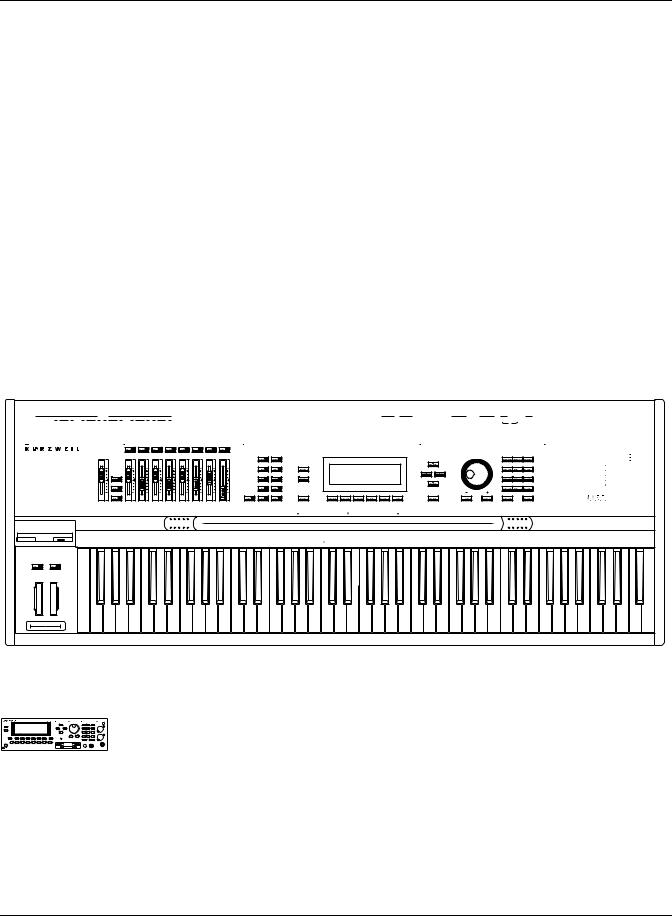Kurzweil Music Systems K2500X, K2500R, K2500 User Manual

Introduction
Welcome!
Chapter 1
Introduction
Welcome!
Congratulations, and thanks for purchasing a Kurzweil/Young Chang K2500 Series instrument. Whether you’ve just gotten a K2500 (illustrated below), the 88-note K2500X, or the rack-mountable K2500R, you’ve got your hands on an extremely capable musical instrument. The K2500 Series instruments are packed with great acoustic, electric, and synth sounds— combined with some of the most advanced synthesis features available, which you can use to create almost any sound imaginable. If you liked the award-winning K2000, you’ll love the K2500!
This manual and the accompanying Reference Guide, as well as the video tutorial, will get you started with your new instrument. You’ll definitely want to keep the manuals handy as you become an advanced user, too.
Headphones |
|
Mix |
|
|
D |
|
Audio Outs |
C |
|
|
B |
|
|
A |
|
|
|
|
|
|
|
|
|
|
MIDI Select |
|
MIDI |
SCSI |
|
Switch Pedals |
|
CC Pedals / Breath |
KDS Output |
Power |
|||
R |
L |
R |
L |
R |
L |
R |
L |
R |
L |
Optical Out |
|
Digital Out |
Digital In |
Optical In |
LoZ Left In |
LoZ Right In |
HiZ In |
Out |
Thru |
Out |
Out/Thru |
In |
4 |
3 |
2 |
1 |
Breath |
2 |
1 |
|
|||||||
|
|
|
|
|
|
|
|
|
|
|
|
|
|
|
|
|
|
|
|
|
|
|
|
|
|
|
|
|
SCSI Thru |
|
|
|
|
or |
|
|
|
|
|
|
|
|
|
|
|
|
Assignable Controllers |
|
|
|
|
|
|
|
|
|
|
|
|
|
|
|
|
|
Data Entry |
|
|
|
|
|
|
|
|
||
|
|
|
|
|
|
|
|
|
1 |
|
2 |
|
3 |
|
4 |
5 |
6 |
7 |
8 |
|
|
|
|
|
|
|
|
|
|
|
|
|
|
|
|
|
|
|
|
|
|
|
|
|
Master Volume |
|
A |
|
B |
|
C |
|
D |
E |
F |
G |
H |
|
|
Program |
MIDI |
|
|
|
|
|
|
|
|
|
|
|
|
|
K2500 |
|
|
|
|
|
|
|
|
|
|
|
|
|
|
|
|
|
|
|
|
|
Mute 1 |
|
|
Previous Pg |
|
|
|
|
|
|
|
|
|
1 |
2 |
3 |
|
|
|
|
|
|
|
|
|
|
|
|
|
|
|
|
|
|
|
|
|
|
Zoom - |
|
|
Gain - |
|
|
|
|
|
|
|
|
|
ABC |
DEF |
GHI |
|
|
|
|
|
|
|
|
|
|
|
|
|
|
|
|
|
|
|
|
|
|
|
Setup |
Master |
|
|
|
|
|
|
|
|
|
|
|
|
|
Forty-Eight Voices |
|
|
|
|
|
|
|
|
|
|
|
|
|
|
|
|
|
|
|
|
|
Mute 2 |
|
|
Mark |
|
|
|
|
|
|
|
|
|
4 |
5 |
6 |
Digital Multi Effects |
|
|
|
|
|
|
|
|
|
|
|
|
|
|
|
|
|
|
|
|
|
Zoom + |
|
|
Gain + |
|
|
|
|
|
|
|
|
|
JKL |
MNO |
PQR |
|
|
|
|
|
|
|
|
|
|
Solo |
|
|
|
|
|
|
|
|
|
|
|
|
Q Access |
Song |
|
Chan/Bank |
|
|
|
|
|
|
|
|
Multi-Track Sequencer |
|||
|
|
|
|
|
|
|
|
|
|
|
|
|
|
|
|
|
|
|
|
Mute 3 |
Jump |
|
|
|
|
|
|
|
|
|
7 |
8 |
9 |
||||
|
|
|
|
|
|
|
|
|
|
|
|
|
|
|
|
|
|
|
|
|
|
|
|
|
|
|
|
|
|
|
|
Expandable to 28MB of Sound ROM |
|||||
|
|
|
|
|
|
|
|
|
|
|
|
|
|
|
|
|
|
|
|
|
Samp/Sec |
|
|
Link |
|
|
|
|
|
|
|
|
|
STU |
VWX |
YZ |
|
|
|
|
|
|
|
|
|
|
Mixdown |
|
|
|
|
|
|
|
|
|
|
|
|
Effects |
Disk |
|
Layer/Zone |
|
|
|
|
|
|
|
|
Expandable to 128MB of Sample RAM |
|||
|
|
|
|
|
|
|
|
|
|
|
|
|
|
|
|
|
|
|
|
|
|
|
|
|
|
|
|
|
|
|
+/- |
0 |
|
||||
|
|
|
|
|
|
|
|
|
|
|
|
|
|
|
|
|
|
|
|
|
FX Bypass |
|
|
Compare |
|
|
|
|
|
|
|
|
|
Clear |
|
||
|
|
|
|
|
|
|
|
MIDI Faders |
|
|
|
|
|
|
|
|
|
|
|
Record |
Play/Pause |
Stop |
|
Edit |
|
|
|
Exit |
|
|
|
|
UPPER/lower |
0 - 9 |
Space |
|
|
|
|
|
|
|
|
|
|
|
|
|
|
|
|
|
|
|
|
|
|
|
|
|
|
|
|
|
|
|
|
|
|
|
|
Cancel |
|
Enter |
Variable Architecture Synthesis Technology |
|
|
|
|
|
|
|
|
|
|
|
|
|
|
|
|
|
|
|
|
|
|
|
|
|
|
|
|
|
|
|
|
|
|
|
|
|
|
|
|
|
|
|
|
|
|
|
|
|
|
|
|
|
|
|
|
|
|
|
|
|
|
|
C4 |
|
|
|
|
|
|
|
|
|
|
|
|
SW1 |
SW2 |
|
|
|
|
|
|
|
|
|
|
|
|
|
|
|
|
|
|
|
|
|
|
|
|
|
|
|
|
|
|
|
|
|
|
|
|
For K2500R Owners
Sampler |
Variable Architecture Synthesis Technology |
Throughout the Performance Guide and Reference Guide we’ve simplified things by saying just "K2500" any time we’re referring to features that are common to all instruments in the K2500 Series. Obviously, though, there are some differences between the rack and keyboard models; we’ll point them out where they occur and mark them with a handy K2500R margin symbol such as the one to the left of this paragraph.
1-1

Introduction
Overview of the K2500
Overview of the K2500
The K2500 has been designed to be a versatile instrument both for performance, and for multitimbral sequencing and recording. Its Variable Architecture Synthesis Technology lets you build sounds from realistic instrumental samples and sampled synth waveforms—then modify the nature of those sounds through a dazzling array of digital signal processing (DSP) functions. The K2500 also generates its own synth waveforms, which can be combined with the samples or used on their own. The K2500 packs 8 Megabytes of on-board sound ROM, and you can load samples from disk into optional sample RAM.
Before we get into explaining Variable Architecture Synthesis, here are a few of the features that by themselves make the K2500 an impressive stage and studio machine. It’s fully multi- timbral—different programs can be played on each MIDI channel. It’s 48-note polyphonic, for a full sound no matter how many chords you play. There’s an on-board digital effects processor, providing up to four simultaneous effects, including realtime effects control, internally or via MIDI.
In addition to the standard stereo audio output pair, there are eight separate outputs that can be configured as stereo pairs, or as individual mono outputs. You can also use the separate outputs as insert points for outboard gear.
The K2500 offers eight SIMM sockets (single, in-line memory modules) so you can add optional sample RAM, where you can store samples that you’ve loaded from disk. You can add up to 128 megabytes of sample RAM! (Sample RAM is not battery-backed, so RAM samples are erased from memory when you power down.)
For offline storage, there’s also a floppy drive and two SCSI ports, so you can store files on floppies or on an external hard disk or load them from a CD-ROM drive. The two SCSI ports make it easy to chain multiple SCSI devices together. There’s also provision for an internal SCSI hard disk. You’ll find all this storage potential extremely useful for saving and loading samples, which can be transferred to and from the K2500 using the standard MIDI sample transfer format, or the new, faster, parallel SMDI sample transfer format (SCSI Musical Data Interchange). See the Reference Guide for information about MIDI and SMDI sample transfers.
The K2500’s battery-backed RAM will store about 400 of your own programs, or 30,000 notes recorded in the sequencer. This sequencer (Song mode) lets you play back MIDI type 0 sequences, record and play back your own songs, and record multi-timbral sequences received via MIDI. For more onboard storage you can add the P/RAM option, which will increase your battery-backed RAM to about 1250K, enough to store hundreds of additional programs, setups, songs, and other objects.
The Local Keyboard Channel feature enables you to use the K2500’s tri-zone setups even if your MIDI controller can transmit on only one channel. The K2500 will also rechannelize incoming MIDI information and send it to its MIDI Out port, enabling you to control additional synths on three different channels.
An optional sampling feature is available, allowing you to make your own mono or stereo samples using analog or digital inputs.
And, of course, there’s the incomparable Kurzweil sound. The K2500 comes to you with 200 preset factory programs (called patches, presets, voices, etc. on other synths), as well as 100 multi-zone performance setups. Play them straight from the box, tweak them in any number of ways, or develop your own programs from scratch—which brings us back to the powerful programming capabilities of the K2500.
1-2
